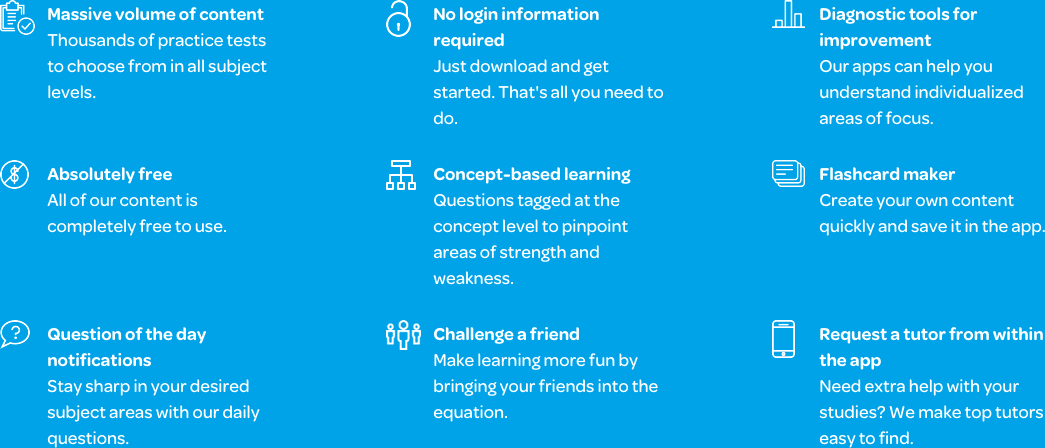The Varsity Tutors SSAT Mobile App
If your child is applying to private schools, they may need to take the SSAT, a two-hour long comprehensive skills exam, as part of the admissions process. The Elementary Level SSAT is for students currently in 3rd and 4th grades. The Middle Level SSAT is for students currently in 5th-7th grades, and the Upper Level SSAT is for students in 8th-11th grades. The exam tests students on their verbal, quantitative, and reasoning skills. The free Varsity Tutors SSAT Prep app for iPhone, iPad, and Android devices can help students review for this important test, and may help them on their way to getting into their chosen school.
All three levels of the SSAT’s Math section include questions about data analysis and probability. Questions range from elementary-level questions about sets and tables to middle-level questions that cover mean, median, mode, range, and Venn diagrams. The upper-level test asks students to identify trends, make inferences, and interpret tables, graphs, and Venn diagrams. All three math tests include questions on numbers, operations, and geometry. The middle- and upper-level tests also include algebra.
The reading comprehension sections include questions relating to poetry and prose, both fiction and nonfiction. As students progress to higher grade levels, they will move from simple comprehension into more difficult concepts, such as making inferences in argumentative science passages, or determining an author’s tone, purpose, and attitude. Middle- and upper-level students will be asked to answer questions on literary fiction that deal with making predictions and recognizing the main idea in passages. In poetry, students will be asked to identify and describe specific details. They will also need to understand and evaluate ideas in poetry.
Each level of the verbal section of the SSAT will ask questions about analogies and synonyms. Analogies are determined based on the relationship between words such as part and whole, example and category, or cause and effect. Students will be asked to answer questions about synonyms for words that have multiple meanings, and to look at word roots, prefixes, and suffixes to identify words of similar meaning.
The practice tests on the Varsity Tutors SSAT Prep app for iOS and Android devices follow the structure of the actual exam, so students are able to become familiar with the way the test is laid out. A student might like to start with one of the full-length, timed practice tests. The results will give them comprehensive feedback on their strengths and weaknesses. It also provides detailed feedback for each answer, showing not only the correct answer, but the relevant concepts, too.
If a middle-level student needs help with finding context-dependent meanings of phrases, or an elementary-level student needs to brush up on how to find the symmetry of lines, Learn by Concept and the flashcards are here to help. These tools are organized by topic, so it’s easy to focus on a single concept. Students can even use the Flashcard Maker to drill on their own customized study material.
To begin reviewing for the SSAT with on-the-go study help, students only need to head to iTunes or the Google Play Store to download the free Varsity Tutors SSAT Prep app today!
66 mobile apps to choose from for your tutoring needs.

Learn More
The SSAT, or Secondary School Admission Test, is an exam students may need to take in order to gain admittance into a private or independent school. It is available for students in elementary, middle, and high school levels. Those who are in grade 3-4 may take the Elementary Level SSAT for grades 4 and 5, fifth through seventh-grade students may take the Middle Level test for grades 6-8, and students in 8th through 11th grade can take the Upper Level version while applying for 9th to 12th grades.
The admission test includes math, comprehension, verbal, and reading questions alongside an unscored essay section. Depending on the grade level, the test is scored on a range of 440-710 with a total range of 1320-2130, or a 500-800 scale with a total range of 1500-2400. The SSAT scores are compared against the scores of students of the same gender that took the same test at the same level during the past 3 years. Most private and independent institutions focus on the percentile rather than scale scores. Students can choose to take the Standard administration on one of the eight possible Saturdays during the school year, or they may use the Flex administration, which is arranged for individual or group testing on eight other Standard days. Each level of the exam is essential the same; it has simply been adjusted to be more challenging for a higher level student.
The tests use a multiple-choice format for the primary testing sections and end with an open-response essay section. The main differences are the concepts the test assesses you in and the number of questions in each section. The first section of the exam is the Quantitative section. There are 30 questions for lower level, or 50 questions for middle and upper level students, with half an hour to complete the exam. The second section is the Verbal section, which spans 30 for lower level or 60 questions for middle and upper level students, with an allotted 20 minutes to complete them. Students are then given a 15-minute break followed by the third section, Reading. There are 28 questions in this section and testers have half an hour to complete them. This is followed by the writing prompt, which allows for 15 minutes.
The Elementary Level Quantitative Section of the SSAT covers a combination of basic mathematical concepts that the student will need to be able to use in the following grade level. They will be asked to demonstrate their abilities with basic arithmetic, such as division, subtraction, multiplication, and addition; graphical interpretation; measurement and geometry; manipulating fractions; place values; and the order of numbers. The Middle Level SSAT primarily focuses on the student's knowledge in elementary level algebra, arithmetic, geometry, and several other topics. They will need to exhibit an understanding of ratios and percentages; sequences and series; addition, multiplication, division, and subtraction; solving for area, perimeter, circumference, and volume; and the Pythagorean Theory. In addition, they will be tasked to use data analysis skills to identify probability based on trends, tables, and graphs. Students who are taking the Upper Level Quantitative section of the exam will find questions that require knowledge of more advanced algebraic word problems, solving exponential problems, manipulating geometrical shapes, and identifying slopes, among others.
The Verbal section dives into a wide range of concepts, regardless of the grade level of the test taker. This section of the exam is designed to assess the individual's understanding of their grade level's vocabulary terms, their ability to form logical relationships between ideas, and their verbal reasoning skills. The SSAT will task the student with forming an interpretation based on analogies, and to identify synonyms for various vocabulary terms. During the verbal section, students will need to be able to show they have a vocabulary and verbal comprehension level that is suited to their current or upcoming grade level.
The Reading section of the SSAT for students in the Lower Level includes seven passages with questions for the student to answer. They may find poetry, cultural fiction, non-fiction, or prose. They may be asked to use close-reading and skimming skills to identify important information and draw conclusions. In addition, they will need to prove they are able to comprehend at the appropriate reading level, which may include answering questions involving main ideas, supporting details, characters, and other information. The Middle and Upper Level SSAT reading sections use passages that have been pulled from a variety of sources, such as biographies, literary fiction, poetry, historical pieces, or from the fields of economics, anthropology, medicine, sociology, and astronomy. Students will need to draw conclusions; identify important details; understand, evaluate, and support arguments; form predictions using the text; be able to express the purpose of the passage.
The Writing sample section of the Elementary Level SSAT gives the student a single prompt. The test provides a picture, which the student uses to create a story from. The evaluation is based on their ability to form a chronologically reasonable creative story. The student has 15 minutes to complete the assignment. The Middle and Upper Level SSAT allows the student to choose one of two creative story prompts. The point of the written portion is to see how well each student can organize and express their ideas. The written assessment is not graded, but it is submitted to each school that the parent or student requested be sent a report.
The Secondary School Admission Test is an important exam for students to take if they wish to get into an independent or private school. It is available to students from elementary through high school, and can help ensure that they have a better opportunity through a specialized program. Students are able to take the test annually. There are schools in the US, China, and other locations around the world that accept SSAT scores. When admission officers are choosing students to attend a school, they typically focus on the percentile to assess a student's preparation for the institution. In some cases, the scores a student has on their SSAT can play a role in getting into the college of their choice.




